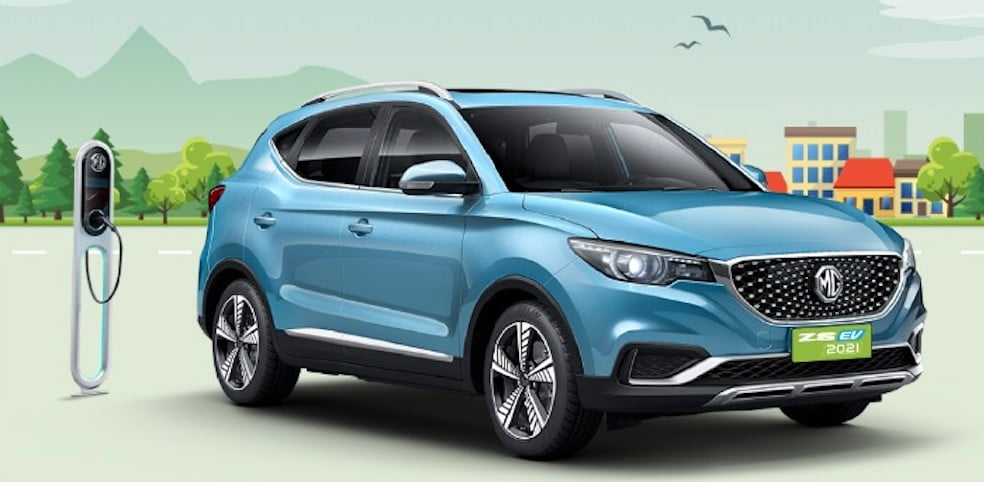The second most popular electric car (EV) in India, the MG ZS EV has received an update. It was launched today with plenty of new technology and features to talk about. Now the sales of the EV segment have been growing steadily in India over the last couple of years, with Tata Nexon EV being the highest-selling electric car in the country. The second spot is secured by the MG ZS EV. These are the only two EVs that have enjoyed success in this segment. The EV market has also been spiced up ever since the news broke out that Tesla will launch its Model 3 in India sometime this year. With a ton of incentives from the government and continuously improving charging infrastructure, the EV market is all set to grow rapidly and exponentially in times to come. MG has made sure to build on a strong foundation laid by the ZS EV in India.
Also read: Tata Nexon vs MG ZS EV – Subscription Model Comparison!
2021 MG ZS EV – What’s new?
While there are fair few changes and upgrades in the 2021 MG ZS EV, we shall try to look at the most important ones at a glance.

New HT (Hi-Tech) Battery
We are aware of the range anxiety that most people in the world suffer from. Actually, it is the most decisive factor in choosing the ICE over the electric vehicle across the globe. While the companies are readily and relentlessly working to maximize the range of an EV, it is still a bit far away for people to get over that fear. The ZS EV is now powered by an evolved 44.5 kWh battery pack which has a claimed range of 419 km. MG has extensively tested the ZS EV across various terrains and under various environments in the country. MG is confident that in most of these conditions, the ZS EV will be able to offer a range of 300-400 km. It produces a very healthy 143PS and 353Nm to facilitate a 0-100 kmph sprint in just 8.5 secs.
Also read: Tata Nexon EV enjoys 64% market share – Check out the reasons why!
Charging Infrastructure
MG has invested heavily in developing charging infrastructure in the country. Since that is what will decide the future of EVs in India, MG has tie-ups with a variety of global companies to make sure that the charging infrastructure to support the EV market evolves quickly. This includes co-operation with Tata Power and Fortum charge and drives to increase the charging locations in the country. Additionally, MG is providing free of cost charging station at the homes of all its ZS EV owners. Also, it has installed over 21 fast-charging stations across the country. All this is in addition to the public charging infrastructure provided by the government. Along with this, MG has also made sure to take care of the recycling aspect of the batteries which is essential in making sure that an EV remains environmentally beneficial. To ensure this, MG has partnered with TES-AMM and Umicore.
Also read: Challenges with Electric Cars in India!
New Features
The 2021 MG ZS EV comes with practical changes for example an increased ground clearance of 177mm and the battery placement at 205mm, along with the new 17-inch alloy wheels. On the inside, the ZS EV comes equipped with a large Panoramic Sunroof and the new connected car technology with i-Smart EV 2.0 app with Gamification to let you know how much CO2 emissions you have stopped, Gaana App with a premium account, PM 2.5 Air Filter and MG’s 5555 eShield service package, along with an 8-year or 1,50,000 km battery warranty. Other features include Heated and Powered ORVMs, 6 Airbags, 6-way adjustable driver’s seat, Rain Sensing Wipers and Leather Seats.
Also read: EV segments in India – Where will Tesla fit in?
2021 MG ZS EV – Prices and Rivals
The new ZS EV comes in two trims; Excite and Exclusive. The Excite variants costs Rs 20,99,800, ex-showroom, whereas the Exclusive variants costs Rs 24,18,000, ex-showroom. This will make it significantly more expensive than its prime rival, the Tata Nexon EV which is priced between Rs 13.99 lakh and Rs 16.40 lakh, ex-showroom. The Hyundai Kona is also the competitor in the same segment but quite honestly, has not been so successful as these two.
Also read: Cost of ownership comparison – Petrol vs Diesel vs Electric Car!

